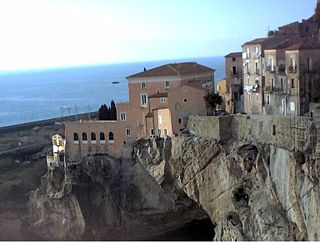History
The small town of Belcastro is situated on a rocky spur crowned by a Norman-style castle that belonged to the counts of Aquino and that some propose as the birthplace of Saint Thomas Aquinas, more commonly taken to have been born in the castle of Roccasecca, not far from Aquino. Feudo for some centuries of the Lords of Aquino, in 1330 by decree of the King of Naples, Robert of Anjou, became a county and changed its name from Geneocastro to Belcastro (Bellicastrum), as a tribute to the beauty of the place and gratification to Thomas 'Aquino, first count of the city and nephew of the saint. In the 15th century it was given the title of city. [1] [2] [3] The historic Lutio d'Orsi [4] (16th and 17th centuries) and the great jurist Giuseppe Poerio (1775-1843), patriot of the Italian Risorgimento and father of the poet Alessandro Poerio, also a great patriot, were born in Belcastro. Its population is now reduced to about 1400 (2013).

Aquino is a town and comune in the province of Frosinone, in the Lazio region of Italy, 12 kilometres (7 mi) northwest of Cassino.

Saint Thomas Aquinas was an Italian Dominican friar, Catholic priest, and Doctor of the Church. He was an immensely influential philosopher, theologian, and jurist in the tradition of scholasticism, within which he is also known as the Doctor Angelicus and the Doctor Communis. The name Aquinas identifies his ancestral origins in the county of Aquino in present-day Lazio, Italy.

Roccasecca is a town and comune in the Province of Frosinone, in the Lazio region of central Italy. It is the birthplace of St. Thomas Aquinas.
This page is based on this
Wikipedia article Text is available under the
CC BY-SA 4.0 license; additional terms may apply.
Images, videos and audio are available under their respective licenses.

Cannae is an ancient village of the Apulia region of south east Italy. It is a frazione of the comune (municipality) of Barletta, a former bishopric and presently a Latin Catholic titular see.

Minervino Murge is a town and comune, former bishopric and present Latin Catholic titular see in the administrative province of Barletta-Andria-Trani in the region of Apulia in southern Italy, lying on the western flank of the Murgia Barese mountain chain.

Cerenzia is a town, comune (municipality), former bishopric and Latin titular see with a population of 1000 people in the province of Crotone, in Calabria region, southernmost peninsular Italy.

Strongoli is a comune and town with a population of over 6000 people in the province of Crotone, in Calabria, southernmost Italy.

Volturara Appula is a town and comune in the province of Foggia in the Apulia region of southeast Italy. Once a flourishing city, the comune now has a population of less than 500.

Amantea is a town, former bishopric, comune (municipality) and Latin Catholic titular see in the province of Cosenza in the Calabria region of southern Italy.

Oschiri is a comune (municipality) and former bishopric in the Province of Sassari in the Italian region Sardinia, located about 170 kilometres (110 mi) north of Cagliari and about 40 kilometres (25 mi) southwest of Olbia.

The Archdiocese of Crotone-Santa Severina is a Roman Catholic ecclesiastical territory in southern Italy, created in 1986. It is a suffragan of the Archdiocese of Catanzaro-Squillace. The historic Diocese of Cortone in Calabria had existed from the 6th century, and was in 1986 combined with the Diocese of Santa Severina. It was a suffragan of the Archdiocese of Reggio. In 2013 there was one priest for every 1, 841 Catholics.

The Italian Catholic Archdiocese of Rossano–Cariati in Calabria has existed since 597, beginning as the Diocese of Rossano. It is a suffragan of the Archdiocese of Cosenza-Bisignano.
The Italian Catholic diocese of Cariati, in Calabria, existed until 1979. In that year it was united into the archdiocese of Rossano-Cariati. It was a suffragan of the archdiocese of Santa Severina, and then of the archdiocese of Reggio Calabria.

The Italian Latin Catholic Diocese of (Diano-)Teggiano-Policastro, in Campania, has existed since 1850, under its present name since 1986. In that year the Diocese of Diano-Teggiano was united with the diocese of Policastro.

The Italian Catholic Archdiocese of Catanzaro-Squillace in Calabria, has existed in its current form since 1986. In that year the Archdiocese of Catanzaro became a metropolitan see, and was combined with the diocese of Squillace.
The Roman Catholic Diocese of Alessano was a Roman Catholic diocese in Italy, located in the city of Alessano, in the province of Lecce, part of Apulia region of south-east Italy. On 28 June 1818, it was suppressed to the Diocese of Ugento.
The Diocese of Strongoli was a Roman Catholic diocese in Italy, located in the city of Strongoli, Calabria. In 1818, it was suppressed, with the bull De utiliori of Pope Pius VII, and his territory was absorbed in the Diocese of Cariati.
Carlo Loffredo, C.R. was a Roman Catholic prelate who served as Archbishop of Capua (1698–1701), Archbishop of Bari-Canosa (1691–1698), and Bishop of Molfetta (1670–1691).
The Roman Catholic Diocese of Fiorentino, named after its see (Castel) Fiorentino, in the present 'commune' (municipality) of Torremaggiore, was a medieval Latin Rite bishopric (1059-1391) and remains a titular see.
Giovanni Andrea Monreale (1653–1726) was a Roman Catholic prelate who served as Archbishop of Reggio Calabria (1696–1726) and Archbishop of Lanciano (1695–1696).
Giuseppe de Carolis (1652–1742) was a Roman Catholic prelate who served as Bishop of Aquino e Pontecorvo (1725–1742) and Bishop of Aquino (1699–1725).






















